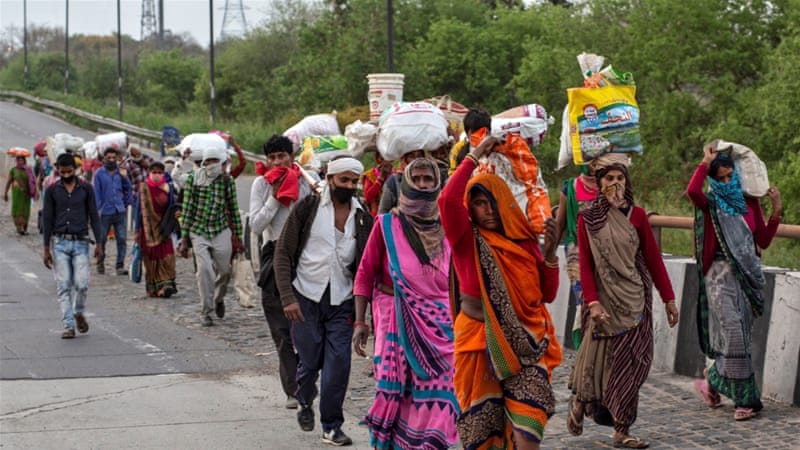Efforts should be made to find ways to accommodate returning migrants.
Return of migrant labourers to their workplaces in southern states of India is likely to take longer than the expected time of around September or October. The unabated spread of Covid-19 through growing number of positive cases is scaring the workers away from catching a return train to cities like Chennai, Hyderabad or Bangalore.
Moreover, the increased allocation of funds for the MGNREGA (Mahatma Gandhi National Rural Employment Guarantee Act scheme) by Rs 40,000 crore, to a total of Rs 1,01,000 crore, which will mostly be spent in the northern states of UP, Bihar, Jharkhand, Bengal, Rajasthan and Madhya Pradesh and Orissa, is another reason for the delayed return to their regular work in the south.
So is another recently launched revamped Pradhan Mantri Garib Kalyan Yojana, primarily aimed at reverse migrated workforce in the above mentioned northern states. But, we all know, these schemes will not be enough to meet the employment needs of our around 10 crore out of the total 14 crore workforce in the country. Sooner than later, they will be returning to their normal daily jobs.
When it happens, a lot will be different from the past when their exodus began early April and continued till late May. The question of migrant labour has assumed greater magnitude than that of health challenges thrown by Covid-19. The fresh challenge thrown at us by the sudden Chinese aggression that claimed as many as 20 lives of our soldiers, is in the form of finding substitute to imports from China.
Now let’s take a look at the big picture today. On the one hand, there is an urgent need to give enough work to the migrant labourers who are on less paid jobs, and, on the other hand,there is a growing demand for banning Chinese products, especially the cheap ones from our markets, so that we can save our economy and deny profits to the companies from across the Line of Actual Control (LAC).
How to combine these two objectives and find a solution that benefits our country? This is a task uppermost on the agenda of the states, particularly those from the south. Officials in the government say that there have been enquires from some labour groups on when and whether they can return to their work, which they had left three months ago.
Of course, flattening of the curve of Covid positive cases is a must for their return. That will happen when the country ramps up its health infrastructure coupled with induction of some approved drugs into the treatment protocol in the next two or three months. Meanwhile, efforts should be made to find ways to properly accommodate the returning migrant labourers.
There are a few PILs (Public Interest Litigation) before several courts, including one before the High Court of Telangana, seeking protection to the migrant workers and another one is before Supreme Court which is clubbed with the “One Nation, One Ration Card” (ONOR) plan. With subtle differences, these two cases pertain to improving the condition of migrant labour.
During the course of hearing of these two PILs, both the Centre and states have told the courts that they had till date no official data on the migrantworkerss.
The figures put out by the governments project the total number of migrants at around four to five crore, based on around 9,000 plus Shramik Rails and other forms of transport provided by them.
Non-governmental sources estimate that the number can be round 14 crore as most of the labourers had either walked back to their villages or found their own transport. Of this, at least 50% of the migrants are from the south, while the rest are from Maharashtra, Gujarat, Delhi, Punjab and Haryana. At least now, the states can maintain official register of labour.
The situation will definitely be not the same againwhen the migrants return to their work which pays them an average wage of around Rs 700 per day, as against around Rs 250 per day now they earn through various government-backed schemes. The factories and big infrastructure firms which faced severe shortage of labour in the last three months have gone for some degree of mechanization.
When the migrants return, they will have to learn to deal with these newly inducted machines. Some amount of skilling and learning is essential for them. States like Andhra Pradesh, Telangana, Karnataka and Tamil Nadu will have to take up programmes to skill and re-skill the migrant labour. But, alas, there are no such plans as of now.
Hyderabad-based National Academy Construction (NAC),which trains construction workersthrough a joint collaboration between private contractors and the public works departments, is ready to provide such programmes, but there is no word from governments. “We have enough facilities and faculty to re-skill our migrant labour, what we need is a direction from the top,” said a functionary of the academy.
Upgrading skills of migrant labour can be used to step up quality of production in both private and public enterprises, thus manufacturing goods that can beat those from China. Import substitution from China can only be found through stepped up quality products in our country. Quality of labour, too, must go up along with it.
Prof P.L. Visveshwar Rao, who filed a PIL in Hyderabad HC, said: “90 per cent of our women labour, while working on sites, wear their men’s old shirts, they don’t even have proper clothing, leave alone uniforms.”
Skill upgrading of these migrants will not cost much, but the benefits would be 10 to 20 fold, according to some top executives of a private infrastructure giant L&T. But, will our governments listen?

